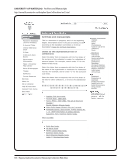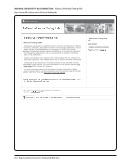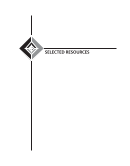SPEC Kit 307: Manuscript Collections on the Web · 61
“It’s at the discussion and theoretical phase, but we are definitely interested and heading that way.”
“Less refoldering, less rearrangement within folders, less photocopying of clippings, briefer and more standardized
descriptions at folder level, briefer scope and content notes, quicker collection level descriptions mounted on
Web.”
“Level of processing varies, depending on importance of collection, preservation needs, received order, patron
requests, donor relations, or other considerations.”
“Meissner and Greene also say that “not all series and all files in a collection need to be arranged at the same
level of intensity.... By selectively arranging individual collection components, rather than rearranging everything,
we can often achieve the greatest labor and access efficiencies focusing attention on a few real problems or
needs so as to achieve a uniform accessibility throughout the materials.” (p. 243). We follow this aspect of
the Meissner and Greene approach and process flexibly and selectively. We do not process all collections or all
parts of collections at the same level. Some collections or parts of collections deserve folder-level arrangement
and detailed finding aids, but some do not. While Meissner and Greene have encouraged us to process less
intensively (e.g., some collections are not refoldered, some photographs are not sleeved, newspaper clippings are
not photocopied, etc.), we do not believe in a one-size-fits-all approach to processing. So, we are not currently
engaged in an effort to make all collections known through collection-level descriptions, whether unprocessed
or processed. We currently do not routinely provide access to unprocessed collections however, this is under
discussion and reconsideration right now.”
“Minimal level processing practical finding aids.”
“Minimal processing is nothing new our predecessors used it generally to process collections. ‘More Product,
Less Process’ simply codifies or standardizes this approach.”
“Minimal processing with collection level records online except for priority collections which are fully processed
with finding aids and container lists, encoded in EAD and cataloged in MARC.”
“Only in a sense. Their approach is far too limiting and lacking in ambition for us to apply uniformly. I prefer to see
their minimal processing as merely the first stage in processing, and gauge the eventual level of processing on the
factors outlined years ago by Bob Warner (and many others). Nearly all of our collections have already reached
this first “minimal” stage, and there are only a small number of collections for which we believe ‘minimal’ is all the
collection will ever receive. In other words, Greene and Meissner articulated one limited version of principles that
were established long before... I believe we follow more in the spirit of a Bob Warner.”
“Please note that Greene and Meissner did not provide any new ideas on processing also their tone was
sometimes rude. We process at all levels. Now we are doing a large collection at the series level.”
“Processing for collections varies greatly, so much so that ‘unprocessed’ is not meaningful. What Greene and
Meissner have proposed has been happening here for years, partly because of the volume of acquisition vs the
resources for processing.”
“Same as it has been expect that we focus more on correspondence files. We decided this because of our findings
with placing 100 HTML finding aids on the Internet in 1999.”
“Since we have container lists for many of our larger, unprocessed collections, we are writing only the briefest of
finding aids and doing little if any physical rearrangement of the collection.”
“It’s at the discussion and theoretical phase, but we are definitely interested and heading that way.”
“Less refoldering, less rearrangement within folders, less photocopying of clippings, briefer and more standardized
descriptions at folder level, briefer scope and content notes, quicker collection level descriptions mounted on
Web.”
“Level of processing varies, depending on importance of collection, preservation needs, received order, patron
requests, donor relations, or other considerations.”
“Meissner and Greene also say that “not all series and all files in a collection need to be arranged at the same
level of intensity.... By selectively arranging individual collection components, rather than rearranging everything,
we can often achieve the greatest labor and access efficiencies focusing attention on a few real problems or
needs so as to achieve a uniform accessibility throughout the materials.” (p. 243). We follow this aspect of
the Meissner and Greene approach and process flexibly and selectively. We do not process all collections or all
parts of collections at the same level. Some collections or parts of collections deserve folder-level arrangement
and detailed finding aids, but some do not. While Meissner and Greene have encouraged us to process less
intensively (e.g., some collections are not refoldered, some photographs are not sleeved, newspaper clippings are
not photocopied, etc.), we do not believe in a one-size-fits-all approach to processing. So, we are not currently
engaged in an effort to make all collections known through collection-level descriptions, whether unprocessed
or processed. We currently do not routinely provide access to unprocessed collections however, this is under
discussion and reconsideration right now.”
“Minimal level processing practical finding aids.”
“Minimal processing is nothing new our predecessors used it generally to process collections. ‘More Product,
Less Process’ simply codifies or standardizes this approach.”
“Minimal processing with collection level records online except for priority collections which are fully processed
with finding aids and container lists, encoded in EAD and cataloged in MARC.”
“Only in a sense. Their approach is far too limiting and lacking in ambition for us to apply uniformly. I prefer to see
their minimal processing as merely the first stage in processing, and gauge the eventual level of processing on the
factors outlined years ago by Bob Warner (and many others). Nearly all of our collections have already reached
this first “minimal” stage, and there are only a small number of collections for which we believe ‘minimal’ is all the
collection will ever receive. In other words, Greene and Meissner articulated one limited version of principles that
were established long before... I believe we follow more in the spirit of a Bob Warner.”
“Please note that Greene and Meissner did not provide any new ideas on processing also their tone was
sometimes rude. We process at all levels. Now we are doing a large collection at the series level.”
“Processing for collections varies greatly, so much so that ‘unprocessed’ is not meaningful. What Greene and
Meissner have proposed has been happening here for years, partly because of the volume of acquisition vs the
resources for processing.”
“Same as it has been expect that we focus more on correspondence files. We decided this because of our findings
with placing 100 HTML finding aids on the Internet in 1999.”
“Since we have container lists for many of our larger, unprocessed collections, we are writing only the briefest of
finding aids and doing little if any physical rearrangement of the collection.”








































































































































































































